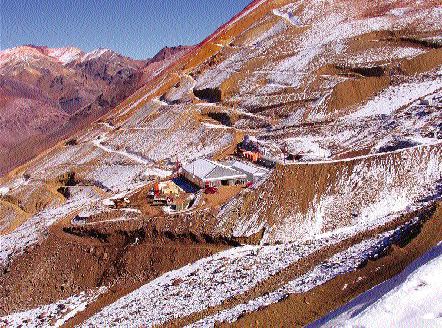Vancouver —
The mine is in the Central Porphyry Copper Belt, which hosts numerous copper mines, including Andina and El Teniente, held by
Rio Tinto signed a letter of understanding, which will serve as the basis for a joint-venture agreement. The company will likely be allowed to earn a 60% interest in the property by spending an unspecified amount on exploration over four years, followed by a feasibility study within seven years.
The companies intend to begin drilling the property before the upcoming Chilean winter.
“We agreed to enter into a binding letter of understanding so that we could get this thing under way,” says SAG&C President Stephen Houghton. “Rio will be doing the work, but we’ll operate it initially because of the time constraints. We have lined up the rigs, and Rio Tinto agrees with the planned drill sites.”
Crews are preparing to drill two targets.
Rio Tinto’s geologists have been to the Pimenton property eight times over the past year, their interest piqued by the presence of chalcopyrite in the old drill core. Rio Tinto’s exploration manager for Peru and Chile had been based at Antofagasta’s mine to the north.
“Rio Tinto’s minimum target size is around five-hundred million tonnes,” says Houghton.
SAG&C’s geologists believe the copper mineralization and the gold veins at Pimenton are a late-stage expression of a porphyry copper system at depth. Of particular interest is a breccia pipe thought to be sourced underneath the Pimenton mine. Drilling at the pipe began in February 2004, and one of the drill holes hit good alteration, with a tourmaline breccia exceeding 80 metres in the core.
The discovery generated much interest in the area last year when open ground around Pimenton was snapped up and sampling was carried out. The interest has heightened, along with the strength in copper prices, and now a flurry of exploration projects (including drilling) is under way. Companies interested in the valley include Anglo American, Codelco,
The Pimenton mine comprises 57.6 sq. km at an elevation of 3,600 metres. The bright-red oxidation on the surrounding hill sides explains the mine’s name.
The company had hoped revenue generated by the small-scale operation would enable it to explore the surrounding ground for a large porphyry system, not unlike others in the Central Porphyry Copper Belt.
The Northern Miner visited the Pimenton mine last June, just as production was ramping up. At the time, the company was selectively mining narrow gold-rich veins from underground stopes and trucking the concentrates to the state-owned Enami smelter.
Pimenton, at 200 tonnes per day, was expected to incur low cash costs, as outlined in a 2003 study by Pincock, Allen & Holt. In its first year, the US$4-million mine was expected to produce the equivalent of 22,200 oz. gold, which would gradually increase to 46,500 oz. per year over a projected life span of seven years. The cash cost was pegged at US$166 per oz., and the internal rate of return, at 117%, based on a gold price of US$320 per oz.
But since our visit, Pimenton has produced only 5,000 gold-equivalent ounces at a cost of US$360 per oz.
“We had some slowdowns,” Houghton concedes. “A large part of the problem had to do with the softness of the gold. When we blasted, the gold got all over the walls, then it stuck to the conveyor belt.”
SAG&C responded by switching from cut-and-fill mining to the stull method, which is often used when mining high-grade veins. “Now we’ve narrowed the stopes to widths of seventy-five to eighty centimetres from more than a metre, and that has significantly increased the head grade.”
The switch (and the need to install new equipment at the mill) necessitated a 45-day shutdown, mainly so miners could be retrained and learn new safety procedures.
The mine is running about six months behind schedule, but now that the mining method has changed, costs are expected to fall to US$220 per oz. The company plans to produce 23,000 oz. gold-equivalent in 2005 (20,000 oz. gold plus about 3,000 oz. in copper and silver). Says Houghton: “We will be cash-flow-positive by the end of April.”
The miners have prepared five stopes but will need to develop more to get the mill running at 200 tonnes per day by year-end. The mill can handle 300 tonnes per day.
Altogether, Pimenton has more than 4 km of underground workings. The veins are only 20-30 cm wide, and reserves are diluted up to 45 cm.
In June 2004, the mine had a proven and probable resource of 67,800 tonnes grading 18.7 grams gold and 1.57% copper, or 40,760 oz. gold and 1,060 tonnes copper, based on a cutoff grade of 12.85 grams gold-equivalent per tonne. The inferred resource is 37,000 tonnes averaging 18.4 grams gold and 1.45% copper in category A and 171,000 tonnes of 19.4 grams gold and 1.6% copper in category B.
“We’ve identified at least two other vein systems via the Esperanza crosscut beneath the main vein systems,” says Houghton. “By June, we should be looking at an extra twenty per cent in resources.”
SAG&C recently purchased the 70-sq.-km Tordillo property, 11 km southwest of Pimenton. (Tordillo is not part of the deal with Rio Tinto.)
So far, only 10% of Tordillo has been explored. Two northwest-trending structures measuring up to 20 metres across yielded samples grading up to 17.63% copper, plus 31.49 grams gold and 25 grams silver per tonne, over 40 cm. The structure is being sampled along what could be more than 1,000 metres of strike extent.
SAG&C plans to run mobile metal ion traverses over the main structure and cover a 400-metre-wide zone that extends for 1,600 metres in an altered brecciated intrusive unit. This zone, south of the northwestern structure, contains specularite and chalcopyrite.


Be the first to comment on "Rio Tinto joins SAG&C at Pimenton"